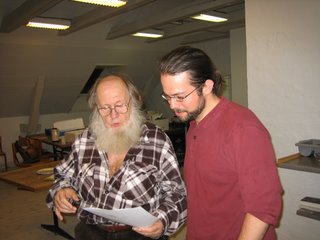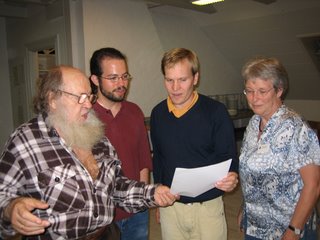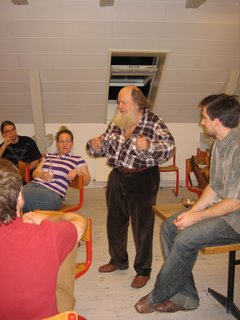Whether one travels to Marseille by plane or train, one generally arrives at the Gare Saint Charles, since that's also where the navette (shuttle) from the airport drops you off following the half-hour ride into town. ("Gare" means "station". "Garer" is the verb "to park", whence the word "garage". Yep, it's not just geography, it's etymology! I love languages.) The front of the gare is actually quite beautiful, with lovely statues and ironwork. I don't have pictures facing the gare, but here you can see the view from the top of the stairs leading down from the station into the city:

The main road leading straight out from the escalier is the Boulevard d'Athènes. Just to the right of center you can see Notre Dame de la Garde. Brilliant location, yes? The Vieux Port is just outside of the scope of this picture, off to the right. The golden statue atop the tower is supposed to represent Mary (la bonne mère) watching over the ships in the harbor and at sea. You can read more of the basilica's history (including speculations as to that hill's religious and military use in ancient times) on the website linked above.
Behind the gare is one campus of the Université de Provence, the one where we spend our Friday mornings in Dr. Hubbard's class and the Teichmüller seminar. Describing the path to the campus is how I can begin justifying the title of the essay. If I had turned around from where I was at the top of the stairs and taken a picture in that direction, you would have seen a plastic wall zoning off a construction area. All along the western side of the gare (the stairs face south, by the way) is a hefty amount of construction. The plan, I think, is to add stores and a parking area. Somehow this construction is taking over the entire street along that side. What should be wide pedestrian areas have been transformed by metal fences into a maze of twisty little passages, all alike. On the far side of the street, more construction walls abound, and in recent weeks have begun diverting pedestrians farther and farther away from various intersections, thus necessitating the introduction of more crosswalk signals. I'm convinced that eventually the entire area will be construction, with no room for either walking or driving.
If instead of going around the gare to the campus you begin walking down the Boulevard d'Athènes, you'll reach the Place des Capucines:

This is not far from where we live. There's a patisserie we're fond of just a few meters back up the street from the Place des Capucines. Once you're there, turn left and you'll see the Eglise des Réformés:

(I have to take a picture of it at night sometime, when the rose window is lit up from inside.) Despite what its name might suggest, it is a Catholic church, and was named for a Reformed Augustinian monastery which existed on the site previously.
Here is where my pictures end. I'd like to keep walking down the Boulevard d'Athènes just a bit, however, until we get to La Canebière. This is the major road leading down to the Vieux Port (on the right); to the left, it also leads to Les Réformés (the street I showed you isn't parallel to La Canebière). La Canebière is a mess right now, with massive construction again encroaching on pedestrian areas. "Encroaching" is perhaps not the right word -- "engulfing" might be more accurate. Marseille is in the process of installing a new tramway system. This involves a complete redesign of the sidewalks along with the basic work of laying down the rails. Along this road, the effect has mainly been squeezing the traffic. In other places around town, the construction involves frequent changes in the routes and direction of traffic. As one postdoc who's working here said, "I ride my bike around here a lot, and it's like the topology changes every day."
Enough complaining about construction. (Mostly it makes me glad not to be driving.) I want to describe the Vieux Port, because it's a nice place for evening walks. I wish I had pictures of it right now. I've been down there twice by myself (in very different moods), and a couple of times with friends. It's a popular gathering spot; one finds many couples and groups of friends chatting on benches along the waterfront. During the day lots of fishmongers line the waterfront.
At night a few people fish in between the docked ships. Once I saw a couple struggling to get their fishing line to work, and they asked another man to help them out. By working together, they discovered that the casting mechanism just didn't work well. So they just kept the line in close to the shore. I believe they and the other fisherfolk I saw were using bread as bait. A couple small schools of perhaps twenty or thirty fish moved mysteriously about. The man in the couple watched a small fish dart towards and away from his hook, until he pulled the line out and the hook was stripped clean. His wife/ladyfriend chortled, and they began discussing what kind of bait would be better. Crevettes (shrimp), one proposed. Then the man who was helping walked over to a nearby puddle of standing water, and pointed out that it contained a handful of tiny fish, which could be used as bait for the larger fish. He caught one for them, and they gave it a try. While their new bait bobbled in the water, I walked over to the puddle, as well. The man noticed my somewhat bemused air, and explained that when boats come in and dump fish on the quai, these little fish are left in the puddles after the rest are taken away. The woman came over and pleaded for him to catch another piece of bait, because the one they were using had died and stopped wriggling. He did, and the guy in the couple exclaimed, "Putain! Tu es plus rapide que le poisson!" ("Putain" is the mild vulgarity of choice in Marseille.) The new bait secured, he dropped the line back in the water and started saying, "Viens, viens, grand poisson, mange le petit poisson." ("Come, come, big fish, eat the little fish.") That was enough of that story for me. I sort of wished I had stayed to see if they caught anything, but I wanted to move on and see other things.
One of my favorite sights at the Vieux Port is a massive school of silver-scaled fish swimming about just at the top of the harbor. In sunlight or lamplight, their writhing motions occasionally turn each of them so that they reflect light off their sides to the observer. It's like watching aquatic fireflies. Also at night, Notre Dame de la Garde is brilliantly illuminated and stunning from the harbor. (I tried to get a picture of that one night, but the battery in my camera was worn out.)
Out past the mouth of the harbor rests the Château d'If, a former island prison made famous by Dumas when he unjustly imprisoned his Count of Monte Cristo there. I do have a picture of this from a distance, taken from a spot where the Hubbards often like to swim:

I certainly plan on making it out to visit the château sometime.
The population of Marseille is dominated, at least in our neighborhood, by North Africans. You're as likely to hear Arabic on the streets as French. Lots of stores had special offers and special hours while Ramadan was happening a couple of months ago. A fortunate side effect of this demographic is the presence of lots of couscous restaurants. In about a four block radius of our house, I've found at least a half-dozen, without really looking hard. The two nicest ones I've been to are Le Femina, on the Rue du Musée, and one down by the Vieux Port whose name I don't know (although inside they have posted a brief story on the 7th century Berber princess Kahena). I've tried a handful of others, and there are two in our neighborhood that I like and are reasonably priced to eat there once a week or so.
The major type of restaurant one encounters on the streets here serves kebab sandwiches. A kebab in this case is an immense amount of lamb skewered, roasted, and left to rotate next to a heating grill in the storefront for who knows how long. It's the sort of thing Americans might find slightly sketchy, but delicious once you try it. My favorite is near the Eglise des Réformés; their sauce and seasonings are the best, and the seating area is spacious and clean.
I've already talked a bit about the open fruits and vegetables market, of which I still highly approve. The metro system is convenient for us (since we live so close to the train station). Lots of little things make this a good place to live. Lots of other little things make it really hard, but I'm not going to share those here right now. This hopefully gives you a picture of what I find fascinating about Marseille.






